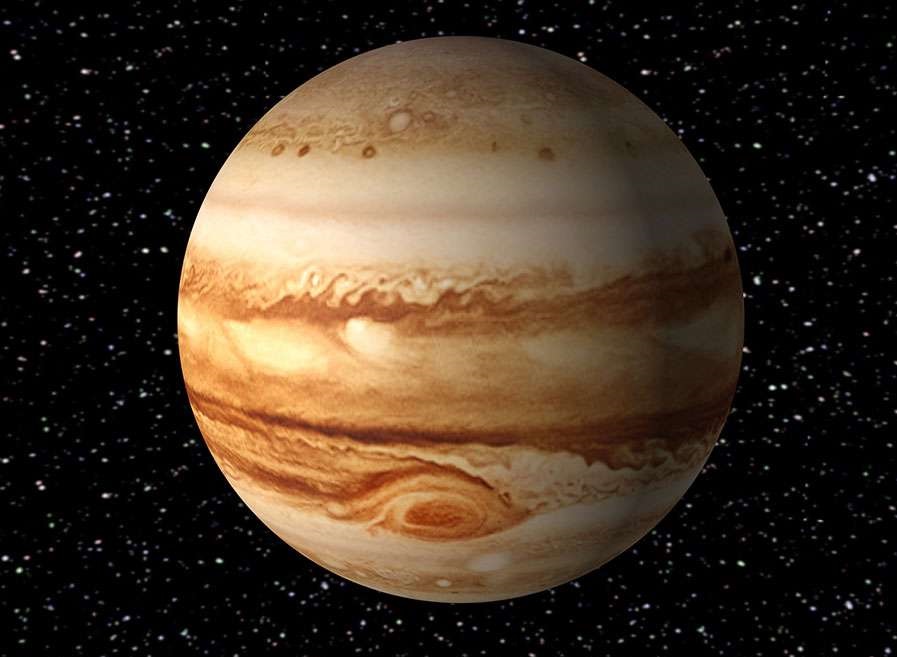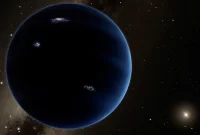6 interesting facts about Jupiter
As NASA’s Juno probe begins its descent (in 2016) to approach the planet Jupiter, let’s take a look at some interesting facts about this giant planet, the most massive in the solar system.
Her size
We cannot talk about Jupiter without mentioning its size. Jupiter is the largest in the solar system.
Its diameter is ten times that of the Earth and its volume is such that it could hold 1,321 Earth. There are storms and cyclones on Jupiter that are larger than our entire planet.
Jupiter is also the most massive of the planets: it is more massive than all the planets put together, and even more than all the other moons, asteroids, comets that we would add to all that.
Jupiter has a mass that is nowhere near as large as that of our Sun, but it is, on the other hand, sufficient for the Jupiter-Sun barycenter to be located outside the Sun. This means that even though Jupiter revolves around the Sun, the Sun also revolves around Jupiter a bit (in reality, both revolve around their barycenter).
Its rotation
Jupiter is the fastest rotating planet: it spins around in less than 10 hours. With its size, this large rotation has a significant effect on the shape of the planet: it is clearly flattened at the poles and bulging on the equator. Matter at the equator therefore travels so fast that centrifugal force deforms the planet.
Its gravitational influence
All the planets have a gravitational influence on the other stars, but Jupiter, because of its great mass, influences much more.
Jupiter is believed to have protected and continues to protect life on Earth, attracting comets and asteroids that might otherwise have damaged Earth (and life) and the rest of the Inner Solar System to it.
Jupiter’s influence is also what would have drawn the planet Neptune into the solar system. Planets formed from remnants of dust and gas that did not form the Sun. Except for Neptune, it is believed that the amount of gas available in its orbit would never have been sufficient to form a planet besides Uranus. Neptune would therefore have formed much further and eventually deviated by Jupiter to approach the Sun.
Jupiter is in orbital resonance with all the other giant planets: when Jupiter makes five revolutions, Saturn makes exactly two, and when Uranus and Neptune make one revolution, Jupiter makes 7 and 14 respectively.
This regularity makes it possible to stabilize certain orbits around the Sun and is responsible for the precision of this celestial mechanics. It also has other effects, for example on asteroids, as you will see.
Kirkwood’s shortcomings
The asteroid belt extends between the orbits of Mars and Jupiter. This is a very large region that stretches almost twice the Earth-Sun distance. The distribution of asteroids over this range of possibility could be uniform, but there is Jupiter and its gravitational influence.
There are “empty” areas in the asteroid belt in specific places. These areas correspond to the orbits that resonate with Jupiter’s orbit and are called Kirkwood gaps.
Each time an asteroid passes as close as possible to Jupiter, it is very slightly deviated from its equilibrium position in orbit. The star will then spend the rest of the orbit trying to refocus on it by oscillating.
In some orbits, the orbital period is an integer multiple of the oscillation period: the two phenomena therefore resonate. As a result, the deviation of the asteroid is accentuated each time it passes in front of Jupiter until the asteroid is ejected from its orbit.
Eventually, there are entire regions where asteroids have been ejected, and we see gaps very precisely located on the asteroid belt.
To put it another way, the presence of these gaps indicates the presence of a very massive planet, and their observation helps determine the position of that planet’s orbit.
All planets have an influence on the others, and Mars naturally also has a gravitational influence on asteroids, but because this planet is much smaller, the Martian influence is negligible compared to Jupiter.
Trojan asteroids
Among the deflected asteroids, some are completely ejected from the asteroid belt, and end up elsewhere in the solar system. They can be seen crashing into a planet, or simply captured in their force of gravity.
So much of Jupiter’s ~ 70 moons are “potatoid” shaped rocky debris believed to be ancient asteroids.
Other stars are found in the same orbit as the planet, generally offset by an angle of 60 ° with the Sun, before or after with the planet. We then speak of Trojan asteroids: Jupiter counts nearly 6,000 (almost all the Trojan asteroids) and the Earth also has one.
These Trojan asteroids are in fact in a gravitationally stable region , called the “ Lagrange point ” : the attraction of the Sun and the planet stabilizes and the asteroid remains where it is : there are 5 Lagrange points for each doublet of celestial bodies ( named L1 , L2 , L3 , L4 and L5 ) but only the points L4 and L5 are stable and they are the ones that host the Trojan asteroids , at an angle of 60 ° ahead and behind the orbit of Jupiter .
Io’s plasma torus
Jupiter, like the Earth has a magnetosphere: the metallic (and therefore conductive) heart of the planet rotates and generates a magnetic field. Jupiter’s is 14 times more powerful than Earth’s.
The magnetosphere is the region where this magnetic influence is preponderant over other forces and influences: it is this which deflects charged particles that would otherwise be attracted by gravity to the planet.
One of Jupiter’s moons, Io, sits in the middle of this magnetospheres, and this configuration is responsible for several of the solar system’s most spectacular structures. One is Io’s plasma torus.
Jupiter’s magnetic field, in a 10 hour period rotation with the planet, spins much faster than the moon Io. As a result, this magnetic field tears about 1 tonne of ionized matter from Io’s atmosphere every second. A belt of these ions then appears around Jupiter.



